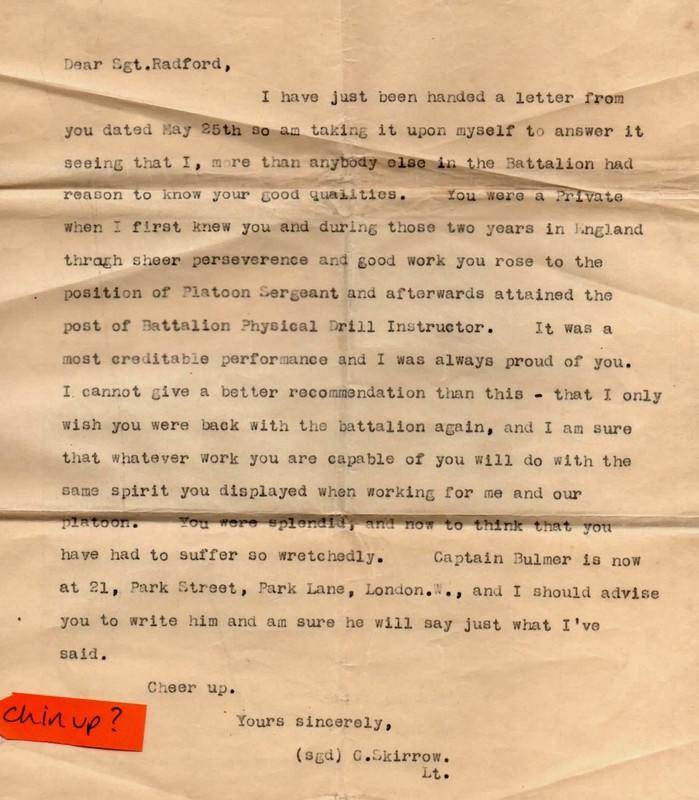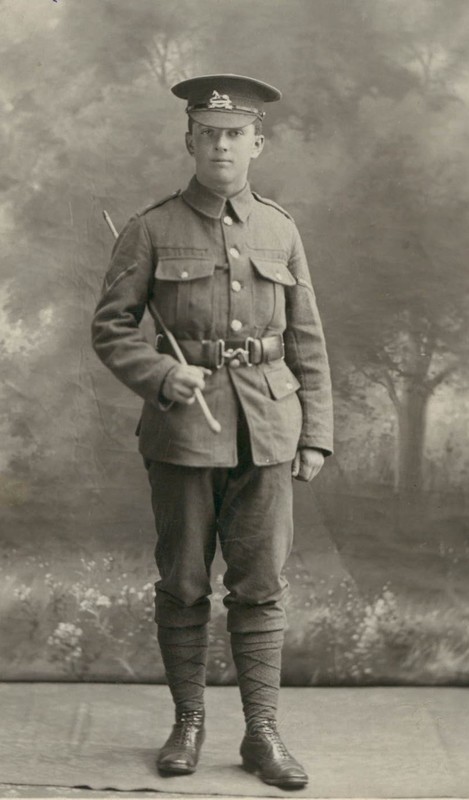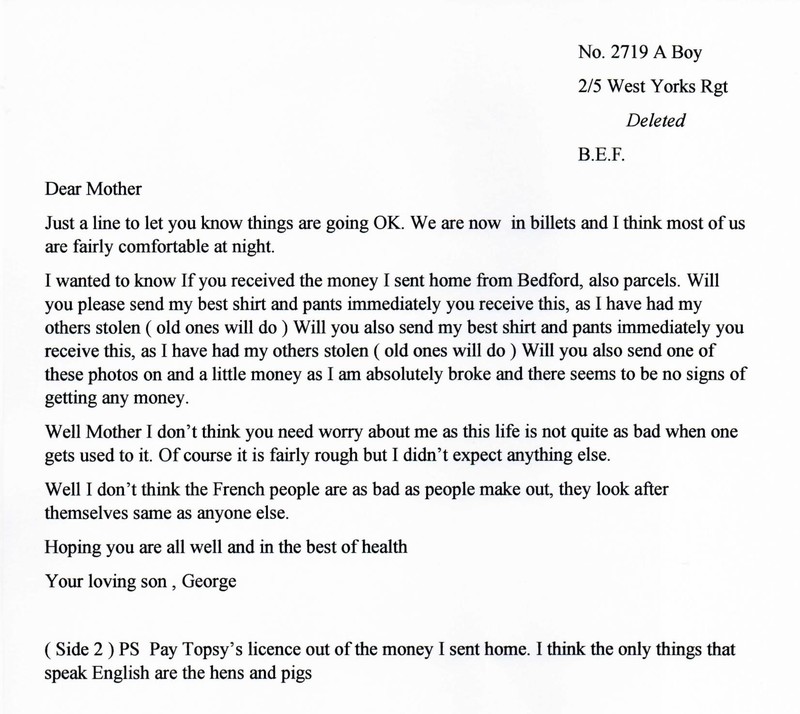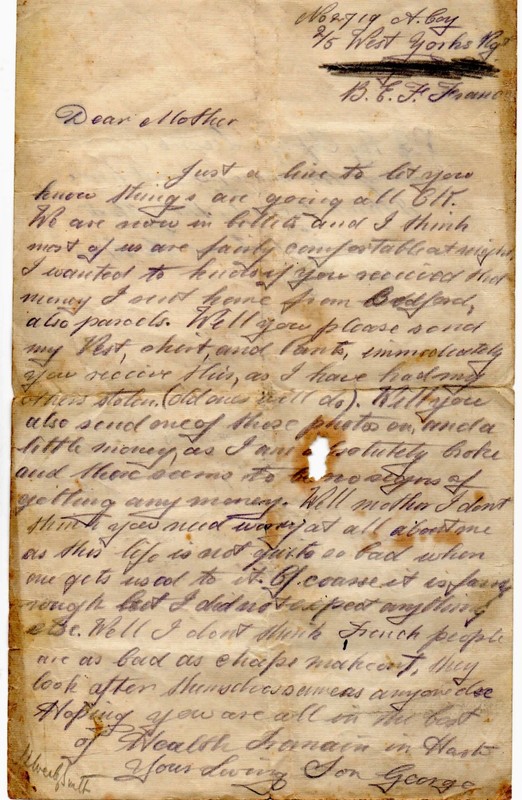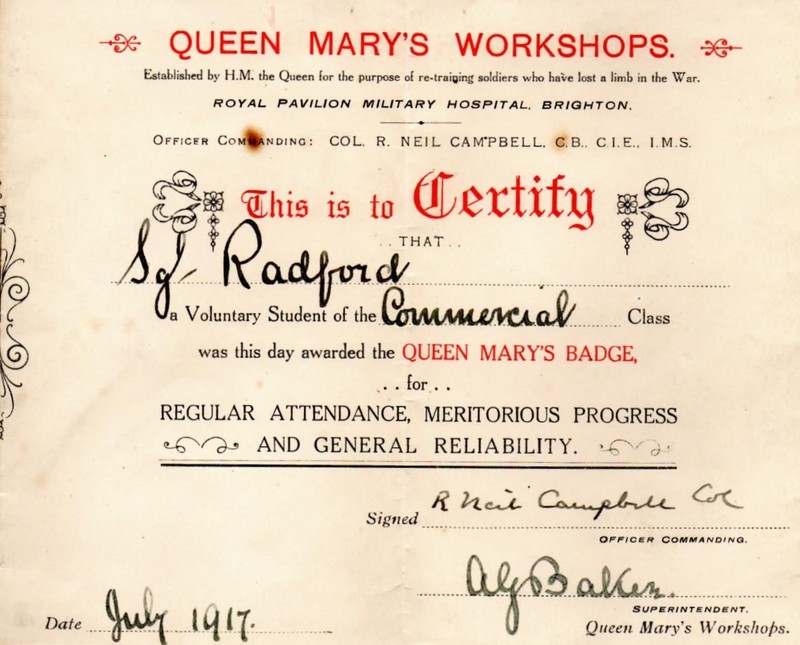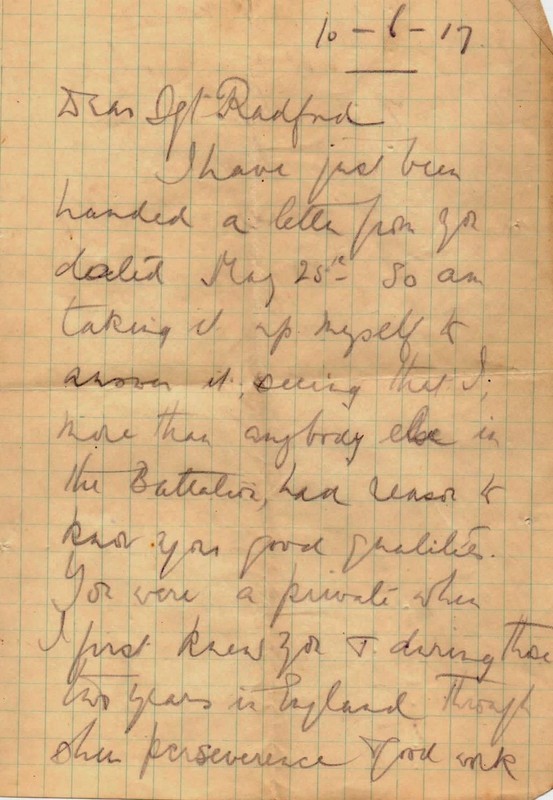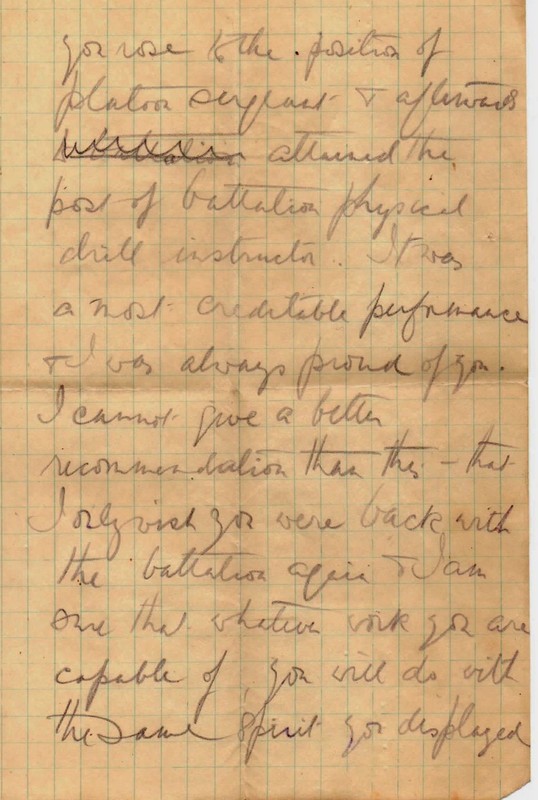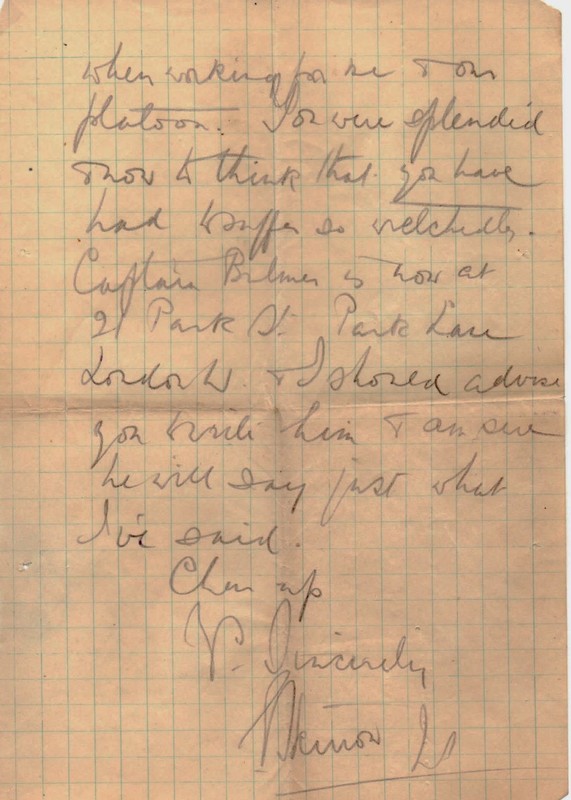Sgt George R Radford (photographs; letters; certificates)
Item
Title
Sgt George R Radford (photographs; letters; certificates)
Who?
Sgt George R Radford
Item(s)
Personal photographs, letter home, Queen Mary's Workshop Certificate, Letter from Lieut. C. Skirrow and transcript.
Story
2719 Sergeant George R Radford, 2nd/5th Battalion The West Yorkshire Regiment
My great uncle, George Radford, was born in York in 1895, the seventh of ten children. In 1914 he was a physically fit, strong 19 year-old with a feeling for adventure. When war broke out, he immediately volunteered to join ‘Kitchener’s New Army’ and was sent to train at Aldershot as a Physical Training Instructor. To quote a letter sent in 1917 from a Lieutenant Skirrow who knew George throughout his army career: ‘Through sheer perseverance and good work, you rose to the position of Platoon Sergeant and attained the post of Battalion Physical Drill Instructor to the 2nd/ 5th Battalion, The West Yorkshire Regiment’.
On 17 February 1917, Sergeant Radford was in the trenches near Beaumont Hamel, waiting for the start of an attack on the village which was at that time behind German lines. George was detailed to take two men with him to locate the position of a German machine gun that needed to be knocked out before his section could make their attack the following morning. Crawling out into no-man’s land, they were able to pinpoint the offending gun.
Almost back to the safety of their own lines, George and his men were directly hit by a single shell. In an instantaneous flash and explosion, George recalled seeing that his two companions, his rifle and his lower left arm had disappeared. With shrapnel in his neck and a serious arm wound, he fell into the crater. Struggling to put a temporary dressing on his shattered arm, he lost consciousness as snow began to fall. Throughout that night and all the following day as the attack took place, he lay in the shell hole, and in moments of consciousness, piled snow on the stump of his arm.
After twenty four hours unattended, he was found by Canadian stretcher bearers who were collecting the wounded from that day’s attack. They were amazed to find George still alive after being so long exposed; George recalled they carried him to safety with a huge snowball ‘like a Christmas pudding’ still on his arm.
His presence of mind had saved his life. He was taken to a casualty clearing station and laid outside in the falling snow with numerous other wounded, all awaiting attention. His last memory before being taken inside was to warn the medical orderlies to be careful as he had hand grenades in his coat pockets.
After being treated in Rouen, George was repatriated to ‘Blighty’; he recovered at the Royal Pavilion Military Hospital, Brighton , where he trained in the Queen Mary’s Workshop. He was honourably discharged from the Army later that year, and made his way to Manchester where he lived in a Salvation Army hostel, and studied for a teaching certificate in Arts and Crafts. He became an accomplished water colour and oil painter, and a ceramic artist (no mean feat for a man with one hand). He taught practical decorating classes at York School of Art, and also ran a decorating business. He married a fellow Art Lecturer, but she died in 1935. In the 1950s and 1960s George and his car were familiar sights in the lanes round York where he could be seen sketching or painting. He was a keen birdwatcher and enjoyed making pottery birds and animals.
George never spoke to any of his family about his war experiences; however, he did tell me how he had lost his arm when I happened to say I was teaching the events of the First World War. My abiding memory of that day was that my great uncle recalled the sequence of events as if they had occurred the previous week; the details of waiting in the snow at the clearing station were particularly graphic - and not included in this account.
My great uncle was ‘a character’ with a very dry sense of humour who often exasperated his family, but George was never ever heard to complain about his situation. He was like so many of his generation who answered the call to fight for ‘King and Country’; he, and they, witnessed and experienced unimaginable horrors, then came home – and just ‘got on with it’.
Note: British attacks on the Somme front stopped for the winter in November 1916. For the rest of the year and through early January 1917, both sides were reduced to surviving the rain, snow, fog, mud fields, waterlogged trenches and shell-holes. By March 1917, preparations were well underway for the offensive at Arras. The Fifth Army was instructed to launch systematic attacks to capture portions of the German defences. Short advances could progressively uncover and attack the remaining German positions in the Ancre valley.
My great uncle, George Radford, was born in York in 1895, the seventh of ten children. In 1914 he was a physically fit, strong 19 year-old with a feeling for adventure. When war broke out, he immediately volunteered to join ‘Kitchener’s New Army’ and was sent to train at Aldershot as a Physical Training Instructor. To quote a letter sent in 1917 from a Lieutenant Skirrow who knew George throughout his army career: ‘Through sheer perseverance and good work, you rose to the position of Platoon Sergeant and attained the post of Battalion Physical Drill Instructor to the 2nd/ 5th Battalion, The West Yorkshire Regiment’.
On 17 February 1917, Sergeant Radford was in the trenches near Beaumont Hamel, waiting for the start of an attack on the village which was at that time behind German lines. George was detailed to take two men with him to locate the position of a German machine gun that needed to be knocked out before his section could make their attack the following morning. Crawling out into no-man’s land, they were able to pinpoint the offending gun.
Almost back to the safety of their own lines, George and his men were directly hit by a single shell. In an instantaneous flash and explosion, George recalled seeing that his two companions, his rifle and his lower left arm had disappeared. With shrapnel in his neck and a serious arm wound, he fell into the crater. Struggling to put a temporary dressing on his shattered arm, he lost consciousness as snow began to fall. Throughout that night and all the following day as the attack took place, he lay in the shell hole, and in moments of consciousness, piled snow on the stump of his arm.
After twenty four hours unattended, he was found by Canadian stretcher bearers who were collecting the wounded from that day’s attack. They were amazed to find George still alive after being so long exposed; George recalled they carried him to safety with a huge snowball ‘like a Christmas pudding’ still on his arm.
His presence of mind had saved his life. He was taken to a casualty clearing station and laid outside in the falling snow with numerous other wounded, all awaiting attention. His last memory before being taken inside was to warn the medical orderlies to be careful as he had hand grenades in his coat pockets.
After being treated in Rouen, George was repatriated to ‘Blighty’; he recovered at the Royal Pavilion Military Hospital, Brighton , where he trained in the Queen Mary’s Workshop. He was honourably discharged from the Army later that year, and made his way to Manchester where he lived in a Salvation Army hostel, and studied for a teaching certificate in Arts and Crafts. He became an accomplished water colour and oil painter, and a ceramic artist (no mean feat for a man with one hand). He taught practical decorating classes at York School of Art, and also ran a decorating business. He married a fellow Art Lecturer, but she died in 1935. In the 1950s and 1960s George and his car were familiar sights in the lanes round York where he could be seen sketching or painting. He was a keen birdwatcher and enjoyed making pottery birds and animals.
George never spoke to any of his family about his war experiences; however, he did tell me how he had lost his arm when I happened to say I was teaching the events of the First World War. My abiding memory of that day was that my great uncle recalled the sequence of events as if they had occurred the previous week; the details of waiting in the snow at the clearing station were particularly graphic - and not included in this account.
My great uncle was ‘a character’ with a very dry sense of humour who often exasperated his family, but George was never ever heard to complain about his situation. He was like so many of his generation who answered the call to fight for ‘King and Country’; he, and they, witnessed and experienced unimaginable horrors, then came home – and just ‘got on with it’.
Note: British attacks on the Somme front stopped for the winter in November 1916. For the rest of the year and through early January 1917, both sides were reduced to surviving the rain, snow, fog, mud fields, waterlogged trenches and shell-holes. By March 1917, preparations were well underway for the offensive at Arras. The Fifth Army was instructed to launch systematic attacks to capture portions of the German defences. Short advances could progressively uncover and attack the remaining German positions in the Ancre valley.
When?
February 1917
Where?
Beaumont Hamel
Contributor
Elizabeth Leopold, great niece.
Collection Day
November 3 2018 Menston
This item was submitted on February 6, 2019

